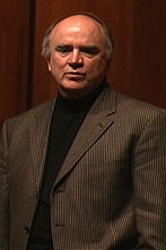|
 |
| E. Lee Gorsuch |
 |
E. Lee Gorsuch: Tom, if I might just add as someone who had the privilege of witnessing this fairly closely, you might bring this back when Emil and others speak next week. I clearly remember the fall of 1971, when this was moving into full conference committee, AFN had its final convention in Fairbanks, Alaska. the convention brought up Ramsey Clark to present the final outlines of the Settlement Act as it was going to move through conference committee.
I remember clearly Calista Corporation, then ABCP, was concerned about the land formula, and the Arctic Slope delegation was equally concerned about it. One feeling was that it should be a population-basis for Natives; another feeling was that it should be on the basis of the lands that were lost. It really became a heated debate, and for a while the feeling was that it might dissolve without resolution, and simply proceed with the direction that had been negotiated to date. There was a break in the convention and then they brought it up. Then they brought the convention to a close before it could break into dissention rather than consensus.
Also, the debate between the Tlingits and Haidas’ inclusion in the settlement, was also a source of contention. As someone who came in working with the state-wide group, I could see those tensions taking place, as each faction had their own lawyers negotiating directly with different elements in Congress, trying to maximize their position. It took a constant effort on the part of some of the leadership to try to keep the whole together, and not letting the differences that were dividing people undermine the approach toward the whole. There were some very anxious moments in the closing days of this momentous piece of legislation.
Tom Richards: Here’s a question for Senator Gravel. Do you think that the Native Americans should have someone who is Native to represent their cultural status on political levels, and why or why not?
Senator Mike Gravel: Yes, I do, but within a majority context. Emil ran for the Congress and I supported him strongly, because I saw the merit that all of you saw—that here was an unusually gifted person who was great at amalgamating disparate interests. But, he was tagged as a Native and couldn’t get a majority vote. I don’t know if, within the Alaska political community, a Native can get elected. My hope is that there will come a time when that will happen -- not because the person is a Native or non-Native, but because the person has unusual merit.
Tom Richards: Thank you, Senator. This next one goes to Joe because he touched on it during his presentations. It sounds like there was a lot of support from everyone everywhere to pass ANCSA. Were there any groups or individuals who opposed the settlement and were they a problem?
Joe Upicksoun: In the view of the Arctic Slope, even if we did oppose the Alaska Native Land Claims bill, it didn’t matter because Congress had that plenary. This is why I would say a gesture of the president of the United States to, on record, say that he had majority approval from the Alaska Natives to accept the Public Draw 92-203.
Senator Mike Gravel: Let me add to that. There was opposition within the preservationist group. They were against development, so they recognized that if the Natives got any sizeable chunk of land, that it would be developed. But these were very liberal times, very revolutionary times, and the environmental community was coming forward. They were trapped into a situation of having to oppose a minority, and that would not wash very well within the national community. In the beginning, there was resentment of that, but it didn’t go any further. That resentment developed into a neutrality within the environmental community.
Tom Richards: Thank you, Senator. There’s a second part to that question. I think I can answer that briefly myself here. Who or what group decided to go through Congress, or was it an obvious realization?
There was the option, that expired some time ago, of going to the Indian Court of Claims, but that was only because it was offered to us by Congress, and the Court of Claims went out of existence at the end of the statutory authority by which it was given by Congress. The U.S. Supreme Court came back to the early 1830s, when, under Chief Justice Marshall ruled that Congress had plenary authority over Indian affairs including termination of rights and property. We didn’t have any recourse, except to go to Congress, unless we wanted just a monetary settlement.
|
 |
|




